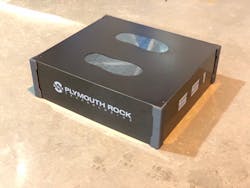Plymouth Rock Technologies, Inc. (PRT) has become a supplier of millimeter-wave (mmWave) components to two leading research organizations: NASA’s Jet Propulsion Laboratory (JPL) and The National Institute of Standards and Technologies (NIST). Interest in the use of signal frequencies in the mmWave range from 30 to 300 GHz has been growing steadily with the adoption of available bandwidths at 24 GHz and higher for 5G cellular communications networks.
PRT’s miniature mmWave sensors and systems meet demanding aerospace and defense requirements for small size, weight, and power (SWaP) making them well suited for integration in smaller unmanned aerial systems (UASs) in commercial, industrial, and military applications as well as in security and threat-detection systems.
“Becoming a supplier for NASA JPL and NIST is not something that is attained easily,” said Dana Wheeler, president and CEO of PRT. “The checks and balances required, along with the quality assurance parameters to do so, are in themselves something we are deeply proud to have accomplished. This announcement demonstrates the caliber of our engineering focus and deep experience to assist in producing highly qualified sensor systems.”
Availability of PRT’s mmWave sensor technologies will aid JPL in efforts to further explore the lunar surface as part of the Artemis program and the next planned trip to the moon. The program is slated to land the first woman and next man on the moon by 2024. “We are proud to supply products and services to these leading and scientifically astute organizations in the multi-billion-dollar aerospace sector,” stated Carl Cagliarini, senior vice president of business development. “We believe that this news not only consolidates our position as a true innovation company, but also elevates our work and brand amongst the major players in aerospace and defense, as well as adding diversity to our revenue stream.”
About the Author
Jack Browne
Technical Contributor
Jack Browne, Technical Contributor, has worked in technical publishing for over 30 years. He managed the content and production of three technical journals while at the American Institute of Physics, including Medical Physics and the Journal of Vacuum Science & Technology. He has been a Publisher and Editor for Penton Media, started the firm’s Wireless Symposium & Exhibition trade show in 1993, and currently serves as Technical Contributor for that company's Microwaves & RF magazine. Browne, who holds a BS in Mathematics from City College of New York and BA degrees in English and Philosophy from Fordham University, is a member of the IEEE.
